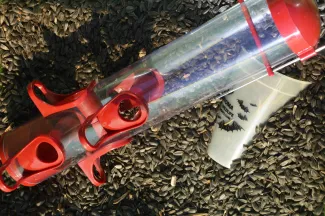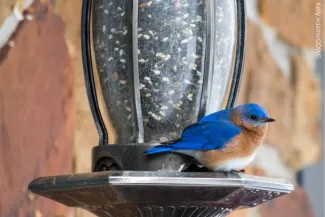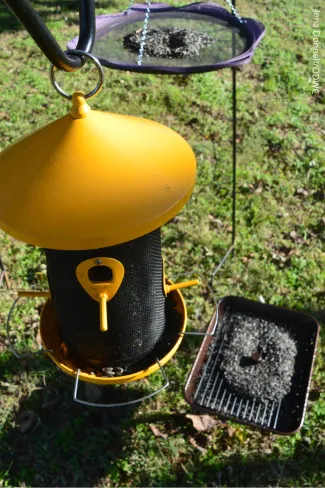Spending more time in nature doesn’t necessarily mean a road trip to a national park or a long hike in the mountains. Instead, it can start in the backyard! Adding a backyard bird feeder is a great way to invite nature into your neighborhood and doesn’t require a lot of planning or a big budget.

A simple feeder and seeds can attract wildlife into your own backyard.
“You can find a no-frills bird feeder for around $8, and a 10-pound bag of black oil sunflower seeds runs just under $9,” said Jena Donnell, wildlife diversity specialist with the Wildlife Department. “You can even make your own feeder by upcycling an empty milk carton or coffee can.”
Feeding birds and watching wildlife at home has long been a popular pastime for our nation. “It’s a simple and fun way to attract birds and other wildlife,” Donnell said. “So much so, that more than 37 million Americans fed wild birds last year.”
Wildlife watching can be enjoyed for a wide range of reasons. “That’s the beauty of it,” Donnell said. “Adding a backyard bird feeder and watching the birds or squirrels that visit is simple R&R for some people, but gives others an outlet for learning more about Oklahoma’s wildlife. It may even kick start a passion for our wildlife.”
Bird feeders can attract wildlife year-round but a majority of feeding stations are active during the winter months when natural foods are in shorter supply.
“Insects are harder to find in the winter so seeds begin to play a more significant role in the bird’s diet,” Donnell said. “Birds are still able to find the food they need in a natural setting, but it’s easier for them to get their fill at a backyard feeder,” Donnell said.

Eastern bluebirds primarily eat insects in the spring and summer, but shift to a seed diet in the winter.
“We have about 50 species of winter birds that regularly use backyard feeders, including many time-honored favorites,” Donnell said. “Cardinals, goldfinches, juncos, and woodpeckers are all reliable visitors to bird feeders, even in towns and cities.”
More elaborate feeding stations will likely produce a wider variety of birds.
“The traditional hopper feeder filled with sunflower seed is a great starting point, but some birds are more comfortable feeding at different heights or are attracted to different styles of feeders,” Donnell said. “Adding a platform feeder at ground level may bring in more doves, junco, or cardinals. Adding grapes or fruit slices may bring in more mockingbirds. A suet feeder may attract more woodpeckers or wrens.”

Multiple feeders, staged at different heights, may attract even more birds to your backyard.
Once the birds or other wildlife discover the feeder, all that’s left to do is watch! If the watching leads to curiosity, online field guides at wildlifedepartment.com or allaboutbirds.org can help with identification and provide more information about the wildlife in your neighborhood.